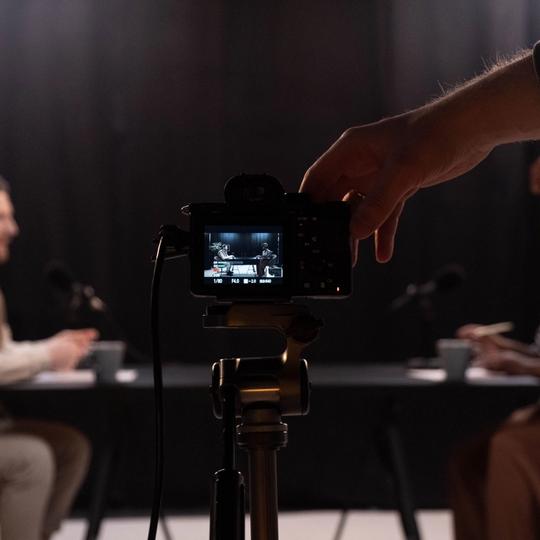
Alyciah Beavers
25-July-23
Learn how to launch a successful podcast with no audience. Discover effective strategies to grow your podcast and engage listeners organically.
Your mind is brimming with brilliant ideas you can't wait to put into the world. So, you're considering starting a podcast. But there's one massive problem that feels insurmountable. You're an amateur with zilch experience creating audio content, and you don't have an audience.
That's perfectly fine! You don't require a large audience to start a podcast. Sure, a large audience would be awesome, but the harsh reality is that unless you're a famous personality or big-shot Instagram influencer with a huge social media following, you won't have a large audience.
But like we said, that's perfectly fine! After all, Rome wasn't built in a day, right? Right! So don't fret if you don't have an audience yet. In this blog post, we'll walk you through how to start a podcast with no audience.
Determine Your Niche
Want to cut through the noise and attract ardent listeners? Then, you'll need to find your niche. Identifying your niche can enable you to differentiate your podcast from others and attract a crowd of loyal listeners.
To pick a niche, here are some tips to consider:
- Consider your passions: Interesting people are interesting to listen to. So, if you want to start a podcast with no audience, you'd better be passionate about the topic you want to discuss. Nobody wants to listen to a podcast that sounds like a boring lecture.
- Think about your expertise: Do you have vast knowledge of a particular topic? Do you have unique perspectives on an issue that could benefit your potential audience? If yes, this can help you find a clear niche.
- Conduct some research: ''Good artists copy, great artists steal.'' So, don't hesitate to steal from others. Assessing other podcasts can help you to determine what content to create and how to set yourself apart from the competition.
- Narrow down on a niche: Don't try to appeal to everyone, even if you have a gazillion interests. Instead, focus on a particular topic. This will help you attract listeners who genuinely want to listen to what you have to say.
Identify Your Target Audience
Sure, you should create content you're passionate about. But it should also resonate with people. Otherwise, you might not attract any listeners.
To choose your target audience, here are some tips to consider:
- Check out the competition: Analyze other podcasts that are comparable to yours and evaluate their demographics, such as age, geography, and gender.
- Create a customer persona: A client or buyer persona is a fictitious portrayal of your ideal listener. Creating one can assist you in tailoring your content to the right audience.
- Use social media: Check where your target audience spends their time online and what they're talking about. This can assist you in creating compelling material that will entice listeners and grow your podcast audience.
Craft Your Brand Identity
Coca-Cola, Apple, Starbucks, Netflix, and Nike. All these brands are instantly recognizable. Why? They have strong brand identities. Your brand identity is what differentiates you from competitors. It's what differentiates Coca-Cola from Pepsi or Netflix Nike from Adidas.
Your brand identity is what makes your podcast unique and memorable. When creating your brand identity, here are some key tips to bear in mind:
- Establish your values: Your brand's values represent what your podcast stands for and your brand's core beliefs. Your values should be reflected in everything you do, from your content to your visual identity.
- Choose a name: Your name is one of the first things people will see when they stumble upon your podcast. Want to stop people dead in their tracks? Then make sure you choose a name that's catchy, concise, memorable, and related to your brand.
- Develop a consistent visual identity: Your brand's visual identity includes your logo, colors, and typefaces. It should be cohesive and reflect your brand's values.
- Develop a tone of voice: This is how you communicate with listeners. Your tone of voice should reflect your brand's personality and resonate with your audience.
- Maintain consistency: Once you've crafted a strong brand identity, stick with it. This means using the same colors, typeface, and tone of voice across all platforms.
Record Your First Episode
Next, on to the exciting but daunting part — recording your first episode! While the steps differ from podcast to podcast, here are the steps generally involved when producing a podcast episode:
- Plan your episode: Determine the topic of discussion, guests, and episode length.
- Perform research: Write a script with talking points or create a questionnaire if you're interviewing guests.
- Record your episode: Locate a quiet place to record your first episode.
- Edit your episode: Remove any unwanted noise and interruptions to ensure your audio sounds clear.
- Add music and effects: Include music and effects to create a more immersive experience for your listeners.
- Master your episode: Master your audio to improve sound quality and create a more enjoyable experience for listeners.
Check our pricing structure for monthly podcast audio plans or use our editing services or use free audio editing software like Audacity or GarageBand to add music and effects to your episode.
And if you're short on content ideas for your podcast, here are some great podcast ideas worth exploring:
Repurpose Your Content
You don't have to craft content from scratch. If you already have existing content, such as YouTube videos, blog posts, and webinars, you can repurpose them for your podcast.
Interview People
Everyone loves a captivating story. If you know people in your industry or field of interest with interesting stories to share, consider interviewing them.
Review Existing Media
Many popular podcasts review movies, TV shows, books, and music. For instance, ''The Watch,'' hosted by Andy Greenwald and Chris Ryan, breaks down trending pop culture topics.
Submit Your Episode to Directories
Once you've recorded your episode, you'll need to submit it to directories. Podcast directories are a centralized place for people to discover new shows. So, when you submit your content to numerous directories, you'll increase your chances of attracting new listeners.
Popular podcast directories include Apple, Spotify, Google, and Amazon Music. Besides these podcasts, you may also want to submit your content to other smaller directories like Stitcher, Pocket Casts, RadioPublic, Castbox, and Podchaser to expand your reach.
Promote Your Podcast
Producing a podcast episode and submitting it to all directories isn't enough to garner a large audience. Sure, you may see some downloads trickle in, but if you want to reach a wide audience, you must market your podcast.
If marketing and self-promotion feel like dirty words that make you shudder, don't fret. There are many simple ways to promote your content, even if you have no audience. Here are some of the most effective ways to market your podcast:
- Social media: Social media platforms like Facebook, Twitter, and LinkedIn are excellent places to promote your podcast. Use these platforms to share podcast trailers, teasers, and even bloopers that make you cringe to generate interest in your podcast and attract listeners.
- Word-of-mouth: Tell your friends, family, and workmates about your podcast. Heck, tell anyone who cares to listen, even your pizza delivery guy, about your podcast. These people could become your first listeners and even staunch brand advocates.
- Join podcast communities: Podcasting can feel awfully lonely when you're starting out and have no listeners. Feeling lost and lonely? Then, join podcast communities. Not only are they an excellent place to grow your audience, but they're also a great place to meet like-minded people, find collaborators, and get invaluable feedback.
- Guest blogging: Have lots to say? Then, consider writing blog posts about your podcast and submitting them to relevant websites to market your content.
- Cross-promote: Reach out to other podcasts within your space for cross-promotion opportunities. You can find fellow creators' content details on their websites or social media.
- Run ads: Paying for ads on social media, search engines, and even other podcasts can be an excellent way to reach a wide audience.
No Audience? No Problem. Start a Successful Podcast Today
Starting a podcast with no audience involves a lot more than just recording an episode, publishing it, and waiting for the downloads to soar. Building a successful podcast with a large audience takes time and effort. So, don't get discouraged if you don't see results overnight.
By following the tips in this blog post and staying patient and consistent, you'll eventually build a successful podcast. Perhaps you might even be the next Joe Rogan! So what are you waiting for? Try us out and start recording the easy way today!


